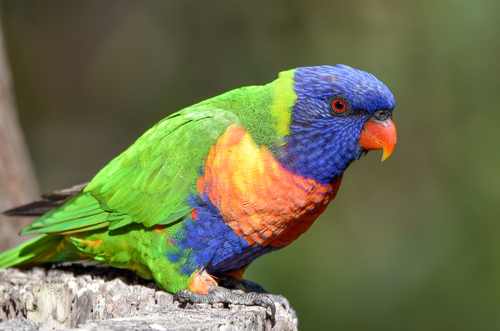
Rainbow Lorikeet
The Rainbow Lorikeet (*Trichoglossus moluccanus*) is a vibrant and highly recognizable bird species native to Australia and parts of Indonesia. Known for its striking plumage, which includes almost every color of the rainbow, this lorikeet plays a crucial ecological role as a pollinator of various native flowering plants. It is a common sight in urban areas and a popular species in aviculture, though its boisterous nature and specialized diet require dedicated care. The Rainbow Lorikeet has significant cultural meaning, with its beauty making it a common subject in art and stories, and its presence often seen as a symbol of vitality and joy.
25-30 cm
Length
40-45 cm
Wingspan
Least Concern
Conservation Status
Distribution
Native to Australia, primarily along the eastern and southeastern coastlines, extending to Tasmania. Also found in eastern Indonesia (the Moluccas and Western New Guinea), and New Caledonia. Introduced populations exist in Perth (Western Australia), Auckland (New Zealand), and Hong Kong.
Lifespan
Typically 7-10 years in the wild, up to 20 years in captivity.
Rainbow Lorikeet's Habitat
Habitat Types
Rainforests, Woodlands, Coastal heath, Mangrove forests, Urban parks and gardens
Climate Zones
Tropical, Subtropical, Temperate
Adaptations
Strong, agile feet for climbing and manipulating food. Brush-tipped tongue for extracting nectar and pollen from flowers. Highly adaptable to urban environments with readily available food sources.
Variations
Several subspecies are recognized, differing slightly in plumage coloration and size. For example, the Swainson's Lorikeet (*Trichoglossus moluccanus moluccanus*) is a commonly recognized subspecies.
Appearance
Breeding Plumage
No significant difference between breeding and non-breeding plumage.
Seasonal Feather Changes
Minimal seasonal variation.
Sex Based Plumage Differences
Males and females have nearly identical plumage.
Notable Features
Bright blue head and belly, Green wings, back, and tail, Orange-red breast with yellow barring, Red beak, Brush-tipped tongue
Diet and Feeding
Primary Foods
Nectar, Pollen, Fruits, Seeds, Insects (occasionally)
Foraging Behavior
Forages in flocks, often hanging upside down to reach flowers. Uses its brush-tipped tongue to collect nectar and pollen. Highly active and acrobatic feeders.
Specializations
Brush-tipped tongue perfectly adapted for extracting nectar from flowers. Strong beak capable of cracking seeds and accessing fruit pulp.
Seasonal Diet Variations
Diet shifts slightly depending on the availability of flowering plants and fruiting trees throughout the year. May consume more insects during breeding season when protein demands are higher.
Behavior
Social Structure
Highly social; forms large, noisy flocks, especially outside of the breeding season. Smaller groups or pairs are common during breeding.
Communication
Loud, screeching calls, Chattering and whistling, Head bobbing and wing flicking (visual displays)
Migration
Generally resident (non-migratory), but may undertake local movements in response to food availability. Some populations show altitudinal migration, moving to lower elevations in winter.
Territorial or Group Behaviors
During breeding season, pairs defend a small territory around their nest hollow. Outside of breeding, they are highly gregarious and form large communal roosts.
Conservation
Threats
Habitat loss (due to urbanization and agriculture), Competition with introduced species (e.g., Common Myna), Disease (e.g., Psittacine Beak and Feather Disease), Illegal trapping for the pet trade (in some areas)
Protection Programs
Protected under Australian law (Wildlife Conservation Act), Habitat restoration efforts in some areas, Monitoring of populations and disease outbreaks
Local National Laws
Protected under various state and national laws in Australia. International trade is regulated under CITES Appendix II.
Population Trend
Stable
Population Estimates
The global population is estimated to be very large, likely exceeding several million individuals.
Interesting Facts
They are important pollinators
Their brush-tipped tongues and foraging habits make them effective pollinators of many Australian native plants.
They can become intoxicated
They sometimes feed on fermented nectar, which can lead to temporary inebriation.
They are highly intelligent
They are known for their problem-solving abilities and playful behavior.
They can mimic sounds
Like many parrots, they can learn to mimic human speech and other sounds.
They are very fast
They are strong fliers and can reach high speed.
Faqs about Rainbow Lorikeet
Are Rainbow Lorikeets good pets?
They can be, but they require specialized care, including a nectar-based diet, a large cage, and plenty of social interaction. They are also very noisy and messy.
What should I do if I find an injured Rainbow Lorikeet?
Contact a local wildlife rescue organization or veterinarian. Do not attempt to care for it yourself without expert advice.
How can I attract Rainbow Lorikeets to my garden?
Plant native flowering trees and shrubs, such as Grevilleas, Bottlebrushes, and Eucalypts. Providing a source of fresh water can also attract them.
Do Rainbow Lorikeets damage crops?
They can sometimes cause damage to fruit crops, but their overall impact is generally considered minor compared to their ecological benefits.
How can you tell the difference between a male and a female Rainbow Lorikeet?
It is very difficult to distinguish between male and female Rainbow Lorikeets based on their appearance alone, as they are almost identical. DNA testing is the most reliable method.
Copyright @ Nature Style Limited. All Rights Reserved.
 English
English